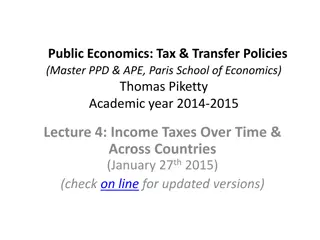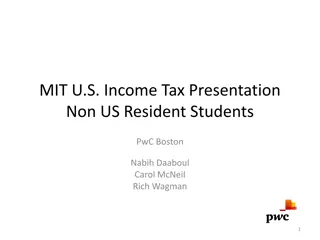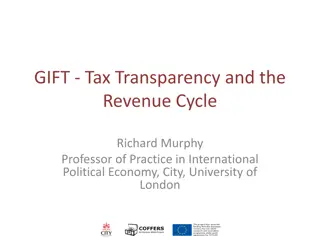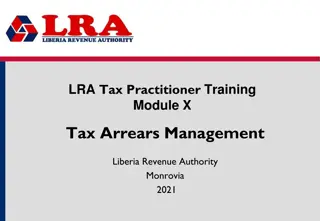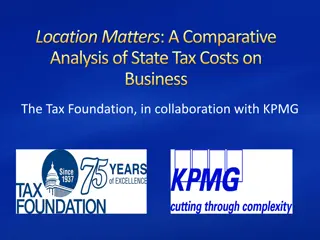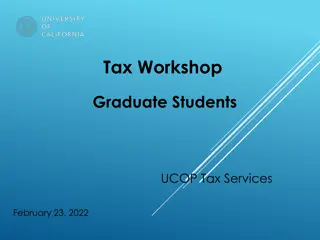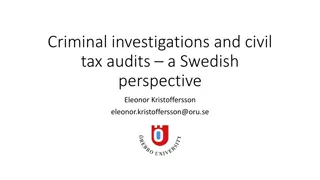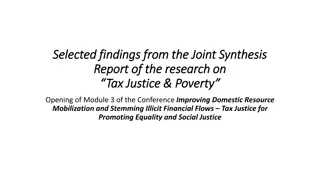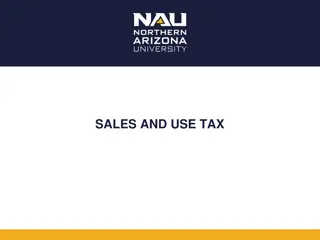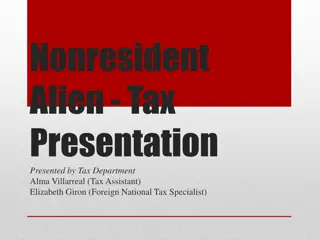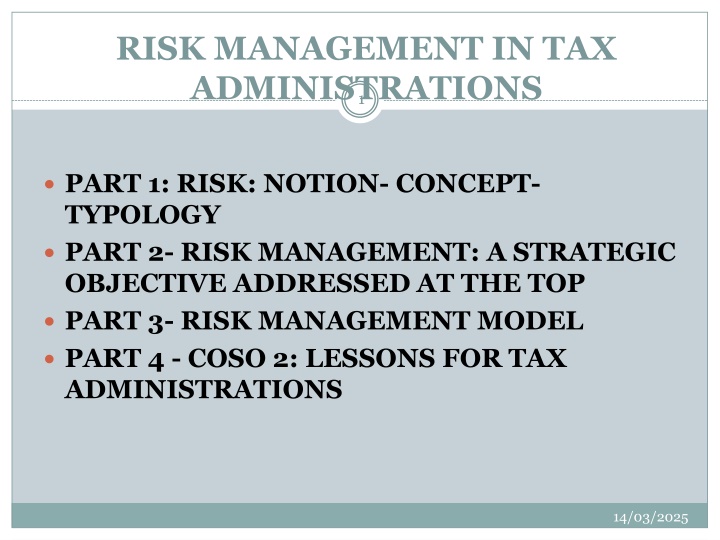
Risk Management in Tax Administrations - Notions, Concepts, Parameters
Understanding risk in tax administrations is crucial for effective management. Explore the multi-faceted nature of risk, ranging from potential events to societal impacts. Learn about risks related to revenue objectives, system failures, and more. Uncover the reasons behind uncertainty and how decision-making plays a key role in risk mitigation.
Download Presentation

Please find below an Image/Link to download the presentation.
The content on the website is provided AS IS for your information and personal use only. It may not be sold, licensed, or shared on other websites without obtaining consent from the author. If you encounter any issues during the download, it is possible that the publisher has removed the file from their server.
You are allowed to download the files provided on this website for personal or commercial use, subject to the condition that they are used lawfully. All files are the property of their respective owners.
The content on the website is provided AS IS for your information and personal use only. It may not be sold, licensed, or shared on other websites without obtaining consent from the author.
E N D
Presentation Transcript
RISK MANAGEMENT IN TAX ADMINISTRATIONS 1 PART 1: RISK: NOTION- CONCEPT- TYPOLOGY PART 2- RISK MANAGEMENT: A STRATEGIC OBJECTIVE ADDRESSED AT THE TOP PART 3- RISK MANAGEMENT MODEL PART 4 - COSO 2: LESSONS FOR TAX ADMINISTRATIONS 14/03/2025
PART 1: RISK: NOTIONS- CONCEPT- PARAMETERS 2 What is risk? Potentiality of occurrence of a feared event. Reaching and exceeding the critical value of a characteristic or a dangerous process, random or not. But also the potential for failure or partial achievement of an objective considered as an expected result. 14/03/2025
PART 1: RISK: NOTIONS- CONCEPT- PARAMETERS 3 Risk: a multi-faceted event The feared event corresponds to a loss whose identity depends on the activity in question: Road safety on weekends: number of deaths or accidents on the road Nuclear accident, Financial crisis, Health scandal Cybercrime Work-related stress.... 14/03/2025
PART 1: RISK: NOTIONS- CONCEPT- PARAMETERS 4 Risk: a multi-faceted event These are all risks that society is increasingly tolerating and demanding to be prevented in an interconnected environment where contagion can be rapid. To ensure their sustainability, reassure investors and meet their regulatory obligations, companies rely on their function. Risk Management 14/03/2025
PART 1: RISK: NOTIONS- CONCEPT- PARAMETERS 5 Risks related to the management of a tax administration The failure to achieve the revenue objectives set by the hierarchy (corruption, incompetence, difficult economic conditions, etc.); The strike of the agents (following a refusal to increase salaries, a bad recruitment policy...) Blocking of the declaration/collection management system (due to a computer failure); A popular uplift (against an increase in the VAT rate;...) .. 14/03/2025
PART 1: RISK: NOTIONS- CONCEPT- PARAMETERS 6 Reasons for risk: uncertainty Decision-making eliminates risk if and only if: - The initial position is completely controlled (quantitatively and qualitatively) - The passage is under total control - The final position is stabilized and controlled. 14/03/2025
PART 1: RISK: NOTIONS- CONCEPT- PARAMETERS 7 INCREASED UNCERTAINTY IN AFRICAN TAX ADMINISTRATIONS Everywhere but especially in African tax administrations, this is made difficult by: Lack of control of statistical information, in terms of taxation But above all the complexity of the environment (legal, technical, economic, social aspects...) Awakening" of the actors (the increasingly demanding and numerous stakeholders: national, local, regional, global: agents, taxpayers, direct administrative authorities, political or local authorities, populations...). Acuity of international tax evasion, Political interventionism in tax decision-making Corruption with its various causes (clientelism, low salaries, lack of control, unshared vision...). 14/03/2025
PART 1: RISK: NOTIONS- CONCEPT- PARAMETERS 8 The dimensions of risk Risk: Probability / severity Bidimensional/ no order relationship between these two elements Uncertainty: undesirable or feared event Unrecognizable: Causes and consequences cannot be assessed, measured or estimated. So it is absurd to probabilize the unknown... Events in this area do not fall into the category of "risk". Risk taking is associated with a set of information leading to a decision, actions and expected results. This information is either known or unknown. 14/03/2025
PART 1: RISK: NOTIONS- CONCEPT- PARAMETERS 9 Risk identification The domain of the unknowable does not allow any description or definition of events either qualitatively or quantitatively since by definition their existence is ignored. It is the unknown that reason and not even imagination can reveal... The elements of this domain are unknown since: They are from another time: past or future They escape our senses: too distant, too small, they have not been discovered... In the knowable, the elements are qualitatively and quantitatively well defined. However, if this description is mastered, it may be different from the sequence of these elements. Ex: Dice game. 14/03/2025
PART 1: RISK: NOTIONS- CONCEPT- PARAMETERS 10 Risk identification So there are two areas in this area: certainty and uncertainty. To a given element, successors are associated. So several probable causes or origins and consequences, possible effects... without being able to say which ones in one way or another!!!! Uncertainty arises from the uncertainty of the starting element or the passage itself, which is not properly controlled. Chance covers the area of the unknowable and the area of uncertainty due to its complexity... several predecessors and 14/03/2025
PART 1: RISK: NOTIONS- CONCEPT- PARAMETERS 11 CERTAINTY/RISK/CRISIS Certainty links a given cause to a specific consequence. In this area, the events are said to be certain. It is the place of quality, safety and regulations that drive it. However, no technical, political or economic activity can remain in the certainty zone forever. A crisis can always arise and push it into the risk zone. 14/03/2025
PART 1: RISK: NOTIONS- CONCEPT- PARAMETERS 12 Risk is defined as the measurement of a set of elements of the hazardous combined with particular conditions, dreaded or not, known or unknown, may lead to harmful or accidental consequences. situation environmental which, 14/03/2025
PART 1: RISK: NOTIONS- CONCEPT- PARAMETERS 13 No dangerous situation, no risk: It is then necessary to learn to manage this risk in several phases: Identify uncertainties and related risks Enter the certainty zone Stay in the certainty zone Compromise policy: technical success and safety Financial efficiency versus taxpayer rights, user service Effectiveness of tax audit versus ethics, deontology! 14/03/2025
PART 1: RISK: NOTIONS- CONCEPT- PARAMETERS 14 Typology OF RISKS Intrinsic or structural risks Functional risks Economic risks. Intrinsic risks: In the elements of the system In the elements used to operate In its products 14/03/2025
PART 1: RISK: NOTIONS- CONCEPT- PARAMETERS 15 Intrinsic or structural risks In the absence of any functioning of the system, each of its elements can be a source of danger. For a motor vehicle, three risks: Fire due to combustible parts, Explosion or fire due to fuel Pollution due to exhaust gas. 14/03/2025
PART 1: RISK: NOTIONS- CONCEPT- PARAMETERS 16 Functional risks Related to the actual functioning of the system and the risks related to the operational environments in which it operates. Acquire resources (energy) to operate Use resources properly Renewing resources These risks have an impact on the performance or safety of the system. 14/03/2025
PART 1: RISK: NOTIONS- CONCEPT- PARAMETERS 17 Economic risks - Linked to circunctions such as location, but also to duration (short, medium or long term). - Also related to direct or indirect effects. 14/03/2025
PART 1: RISK: NOTIONS- CONCEPT- PARAMETERS 18 Risk management Faced with risk, man uses three strategies: Basic research: reduce the area of uncertainty, the unknowable; Applied research: reduce risks in the certainty area, reduce uncertainty; Risk management: enter the certainty zone and stay there. 14/03/2025
PART 1: RISK: NOTIONS- CONCEPT- PARAMETERS 19 Decide despite the risk! Uncertainty unknowable nature of the departure, lead to risk taking in the decision. Hence the importance of identifying and assessing this risk, and finally of managing it. To do this, establish the risk severity scale. about the basic elements, the 14/03/2025
PART 1: RISK: NOTIONS- CONCEPT- PARAMETERS 20 Risk category The activity defines its own risk scale both in terms of terminology and number of steps: o Catastrophic risk o Critical risk o Serious risk o Significant risk o Minor risk 14/03/2025
PART 1: RISK: NOTIONS- CONCEPT- PARAMETERS 21 CASE STUDY: HIGHLIGHT FOR YOUR TAX ADMINISTRATION SOME DETERMINING ELEMENTS and DANGEROUS OR FEARED EVENTS THAT THEY MAY CONTAIN ABOUT TEN FUNCTIONAL RISKS THAT CAN BE ENCOUNTERED THERE ABOUT TEN CYCLICAL RISKS SPECIFY THEIR LEVEL OF GRAVITY 14/03/2025
22 14/03/2025
PART 2- RISK CONTROL: A STRATEGIC OBJECTIVE ADDRESSED AT THE TOP 23 Risk is inseparable from decision-making: whether it is simply operational or truly strategic. Any choice carries its own risk. But things are never binary: with good and bad results for this or that action. This is why corporate risk management is both art and science. The Global Forum noted: "the increasing volatility, complexity and ambiguity of the world". The Global Risks Report 2016, 11th edition, World Economic Forum (2016). 14/03/2025
PART 2- RISK CONTROL: A STRATEGIC OBJECTIVE ADDRESSED AT THE TOP 24 Higher tax authorities have essentially two roles: to create value and to avoid regression of the entity. They can rely on the RM. If globalization unifies practices, the field is open to adaptation according to places, visions 14/03/2025
PART 2- RISK CONTROL: A STRATEGIC OBJECTIVE ADDRESSED AT THE TOP 25 Organizations face difficulties that have a significant impact on the trust and faith of stakeholders and even question their relevance. Indeed, all stakeholders are looking for more transparency and accountability to manage the impact of risk. At the same time, they insist on the leadership's ability to take advantage of the slightest opportunity. 14/03/2025
PART 2- RISK CONTROL: A STRATEGIC OBJECTIVE ADDRESSED AT THE TOP 26 However, even success can bring inherent risks. (For example, in many countries, a successful revenue collection or tax audit campaign can lead to a drastic increase in the objectives administration... The risk performance assigned, the risk of using collection methods that do not respect taxpayers' rights,...). assigned failure to in the the of 14/03/2025
PART 2- RISK CONTROL: A STRATEGIC OBJECTIVE ADDRESSED AT THE TOP 27 This is why organizations need to be more resilient and adapt quickly to change. They must think strategically about how to manage the volatility, complexity and ambiguity of a changing world. Above all, at the top of the organization where decisions impact all activities. 14/03/2025
PART 2- RISK CONTROL: A STRATEGIC OBJECTIVE ADDRESSED AT THE TOP 28 Risk management must be designed with strategy and performance in mind. Managers must then discuss with stakeholders (top and bottom) to answer the question: How to use risk management to gain a competitive advantage? Therefore, risk management must be mobilized in the search for or redefinition of any strategy. 14/03/2025
PART 2- RISK CONTROL: A STRATEGIC OBJECTIVE ADDRESSED AT THE TOP 29 The management dialogue is improved by the MR since for each strategy, it will be considered: - strengths and weaknesses as a condition for change; - Similarly, how a strategy can be properly aligned with the organization's missions and vision. This approach gives management, who will alternative strategies and their consequences before making their selection. more have confidence considered to all 14/03/2025
PART 2- RISK CONTROL: A STRATEGIC OBJECTIVE ADDRESSED AT THE TOP 30 These considerations influence governance and culture, strategy and target setting, performance, information, communication, reporting, review and revision of activities to manage the entity's performance 14/03/2025
PART 2- RISK CONTROL: A STRATEGIC OBJECTIVE ADDRESSED AT THE TOP 31 Integrate strategy and performance. From the outset, when implementing the strategy, the emphasis must be on risk management. Then, strengthen the link between performance and RM as soon as the performance indicators are in place, think about the correlation. Broaden the scope of reporting, information sharing to improve, increase buy-in to the organization by the various stakeholders Use all modern media that can improve or provide satitsitcs, data that support decision making. 14/03/2025
PART 2- RISK CONTROL: A STRATEGIC OBJECTIVE ADDRESSED AT THE TOP 32 Increase opportunities Identify and manage risk throughout the entity - Reduce performance variability: In losses but also in sudden successes. The latter can also cause risks. Improve resource deployment: Each risk leads to a demand for resources. If decision-makers have robust risk information, in the face of limited resources, they must assess all limited resources, prioritize the allocation of these resources. 14/03/2025
PART 2- RISK CONTROL: A STRATEGIC OBJECTIVE ADDRESSED AT THE TOP 33 BUILDING RESILIENCE Over the long term, RM develops the company's resilience, the ability to anticipate and respond to change Help the company to manage not only the risk but the change and how this change could impact performance and require a different strategy. If change is clearly perceived, an organization can shape its own plan. He could review the profile of his investment and even completely change his activity. ERM allows decision-makers to assess risk and to have a specific resilience mentality. 14/03/2025
PART 2- RISK CONTROL: A STRATEGIC OBJECTIVE ADDRESSED AT THE TOP 34 MANAGING RISK MEANS RESPONDING TO CRISES - Decision makers with a good RM strategy know how to manage any crisis - To manage the crisis, it is therefore necessary to prepare it well by ensuring an effective RM model. 14/03/2025
35 14/03/2025
PART 3- A RISK MANAGEMENT MODEL 36 RISK MANAGEMENT PROCESS Organize the transition from an unacceptable risk to an acceptable risk, Relevance and acceptance, Precaution, Prevention, Protection, Exemption or insurance. 14/03/2025
PART 3- A RISK MANAGEMENT MODEL 37 Nature and perception of risk The consideration of a risk and the actions that follow depend on several factors: Risk management policy can be based more on the "probability" or "severity of consequences" component. In a decision-making process, this is where risk perception comes in. An essential component of risk assessment, of a subjective nature, can change the risk profile, the decision maker's assessment of a dangerous situation...by increasing or decreasing one of these values. Personal perception or representation of the risk directly related to the decision-maker's personal experience in the state of his knowledge...about the event in question. 14/03/2025
PART 3- A RISK MANAGEMENT MODEL 38 Managing a global risk To cope with social, economic and regulatory pressure, companies are now moving towards global quality management, which includes safety and environmental concerns. These approaches follow the same overall process (continuous improvement, PDCA) and each lead to the implementation of descriptive manuals, procedures, action plans and traceability tools. This book is the first to synthesize the three concepts, quality, safety and environment, detailing for each the regulatory and normative bases, and giving the methods and tools that allow their implementation in the company. 14/03/2025
PART 3- A RISK MANAGEMENT MODEL 39 Main risk management steps Setting objectives Internal environment Risk identification Risk Assessment Risk information and communication Control of activities Response to the identified risk Risk monitoring and review Risk control 14/03/2025
PART 3- A RISK MANAGEMENT MODEL 40 ISO 31000:2018, Risk management - Guidelines, provides principles, a framework and guidelines for managing all forms of risk. This standard can be used by any type of organization regardless of size, activity or sector. 14/03/2025
PART 3- A RISK MANAGEMENT MODEL 41 ISO Guide 73:2009, Risk management - Vocabulary, which complements ISO 31000 by providing a set of risk management terms and definitions. IEC 31010:2009, Risk management - Risk assessment techniques, a standard focused on risk assessment, which provides decision-makers with better insight into risks that may hinder the achievement of objectives and enables them to assess the adequacy and effectiveness of controls already in place. This standard covers the concepts of risk assessment, processes and the selection of risk assessment techniques. 14/03/2025
PART 3- A RISK MANAGEMENT MODEL 42 COSO; an interesting risk management model COSO was first and foremost an internal control framework defined by the Committee Of Sponsoring Organizations of the Treadway Commission. It is used in particular in the context of the implementation of provisions under the Sarbanes-Oxley, SOX or Financial Security Act, LSF, for companies subject to American or French laws respectively. The initial reference framework called COSO 1 with the initial edition of 1992, has evolved since 2002 into a second corpus called COSO 2. 14/03/2025
PART 4 - COSO 2: LESSONS FOR TAX ADMINISTRATION 43 In its new version, the Coso framework has been improved by extending the objectives relating to financial reporting to non-financial and internal aspects. It also incorporates the many changes in the economic and operational environment in recent years, including expectations for oversight by governance bodies, the globalization of markets and operations, the increasing evolution and complexity of business models, and expectations for fraud prevention and detection. 14/03/2025
PART 4 - COSO 2: LESSONS FOR TAX ADMINISTRATION 44 The purpose of the Integrated Internal Control Framework is thus to enable directors, officers, managers and audit experts to find a detailed answer to the fundamental question: "Is the organization under control? 14/03/2025
PART 4 - COSO 2: LESSONS FOR TAX ADMINISTRATION 45 The COSO framework is based on the following basic principles: Internal control is a process: it is a means, not an end; it is not limited to a collection of procedures but requires the involvement of everyone at every level of the organization. Internal control must provide reasonable (but not absolute) assurance that management comply with the law. Internal control is adapted to the effective achievement of objectives. management and 14/03/2025
PART 4 - COSO 2: LESSONS FOR TAX ADMINISTRATION 46 The frame: the COSO cube The COSO framework is based on the concepts of objectives and components The three objectives The COSO framework defines internal control as a process implemented by management at all levels of the company to provide reasonable assurance that the following three objectives are achieved: the effectiveness and efficiency of operations, the reliability of financial information, compliance with laws and regulations. It should be noted that these objectives largely correspond to investors' concerns. 14/03/2025
PART 4 - COSO 2: LESSONS FOR TAX ADMINISTRATION 47 The five components Internal control, as defined by the COSO, has five components. These components provide a framework for describing and analyzing the internal control implemented in an organization. It is about: the control environment, which essentially corresponds to the values disseminated throughout the company; the assessment of risks in terms of their importance and frequency; control activities, defined as the rules and procedures implemented to deal with risks, with COSO requiring the factual materialisation of controls; information and communication, which must be optimized; management, i.e. internal "control of control". 14/03/2025
PART 4 - COSO 2: LESSONS FOR TAX ADMINISTRATION 48 The cube After the objectives and components, the COSO requires to distinguish the structures of the company (companies, entities, functions,...). The combination of the company's three objectives, five components and structures, seen as three distinct areas of analysis, constitutes what is called the COSO cube. 14/03/2025
PART 4 - COSO 2: LESSONS FOR TAX ADMINISTRATION 49 The advent of COSO 2 - Enterprise Risk Management Framework COSO 2 is now a widespread reference framework for risk management. It has made it possible to move from an internal control approach to risk management. 14/03/2025
PART 4 - COSO 2: LESSONS FOR TAX ADMINISTRATION 50 COSO 2, Enterprise Risk Management Framework (Cadre de r f rence pour la gestion des risques de l'entreprise) is a process implemented by the board of directors, managers and staff of an organization, used for strategy development and transversal to the company. It is intended to: identify potential events that may affect the organization, control risks so that they are within the limits of "Risk Appetite". provide reasonable assurance that the organization's objectives are being met. 14/03/2025

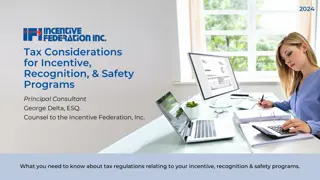
![Town of [Town Name] Real Estate Tax Rates and FY 2024 Budget Summary](/thumb/62211/town-of-town-name-real-estate-tax-rates-and-fy-2024-budget-summary.jpg)





